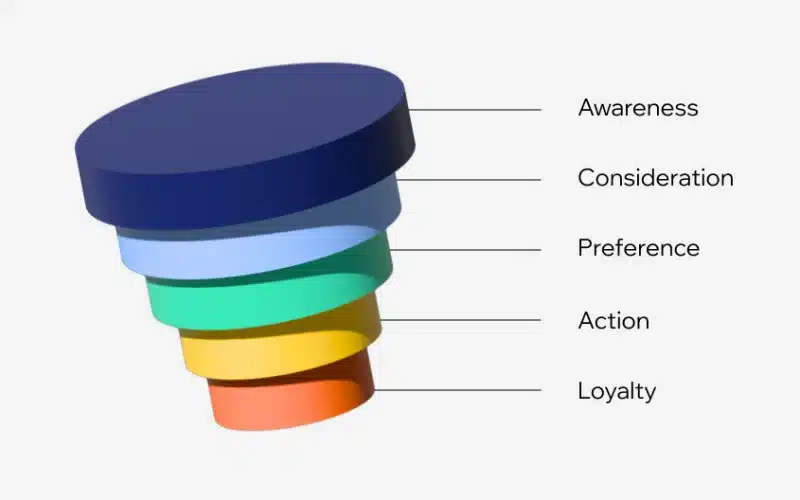In today’s fast-paced business environment, determining how to enhance brand consideration among your target audience is critical. When I first started boosting my brand’s visibility, I found that understanding and applying techniques to increase brand consideration was critical. It wasn’t only about raising awareness of my brand; it was also about making it the preferred option. This voyage revealed great insights, facts, and undiscovered strategies, which I am eager to share with you.
What is Brand Consideration?
Brand consideration is the stage of the customer journey in which potential customers are aware of your brand and are considering making a purchase. This stage is critical because it bridges the gap between awareness and conversion, determining whether a customer would select your brand over competitors.
Why is Brand Consideration Important for Business?
Brand consideration is critical since it immediately influences sales and revenue. Nielsen found that brands with high consideration are three times more likely to be purchased. This means that by prioritizing brand consideration, firms can greatly increase their chances of turning prospects into loyal consumers.
When potential customers consider your brand, they are more likely to progress through the sales funnel, resulting in increased conversion rates. Furthermore, excellent brand consideration can lead to improved customer loyalty and advocacy, because satisfied customers are more inclined to suggest your brand to others. This generates a positive feedback loop, amplifying your marketing efforts and driving long-term growth.
Additionally, brand consideration is important for competitive differentiation. In markets where several brands provide identical products or services, a high level of brand consideration helps distinguish your company from competitors. It communicates to potential customers that your brand is a reliable and preferred option, which might influence their purchasing decisions. For instance, a consumer electronics brand that receives frequent praise from tech enthusiasts will have an advantage over less well-known businesses, resulting in higher sales volumes and market share.
How Do You Measure Brand Consideration?
Measuring brand consideration involves using a variety of indicators and techniques to gain a full understanding of how potential customers perceive your brand. Here are some useful approaches for measuring brand consideration:
#1. Surveys and Feedback Forms
Directly inquire about your customers’ brand consideration. Questions like how likely they are to purchase from your brand, how they view your brand in comparison to competitors, and what variables impact their consideration might be asked. You can distribute these surveys via social media, your website, or email.
#2. Google Analytics
Monitor metrics like website traffic, bounce rates, and conversion rates to determine how frequently potential customers visit your site and take action. High interaction and low bounce rates can imply a strong brand consideration.
#3. Social Media Insights
Platforms such as Facebook, Twitter, and Instagram offer information on how frequently your brand is referenced, shared, and interacted with. These interactions might provide insights into how your target audience regards your brand during their decision-making process.
#4. Brandwatch
This application lets you track online mentions and emotions about your brand. It tracks how frequently your brand is mentioned in conversations in comparison to your competitors, giving you a more complete picture of your brand’s market position.
#5. Net Promoter Score (NPS)
This metric assesses customer loyalty and satisfaction by asking them if they are likely to recommend your brand to others. A high Net Promoter Score (NPS) shows strong brand consideration and advocacy.
#6. Competitor Analysis
Frequently compare your brand’s performance to that of your competitors. Tools such as Ahrefs and SEMrush can help you assess how frequently your brand is searched for and discussed in comparison to competitors, giving you insight into your market position.
By combining these approaches, you may gain a comprehensive understanding of your brand consideration and discover areas for development. For example, if surveys show that low consideration is due to a lack of awareness, you may want to invest more in awareness initiatives. If your social media analytics reveal strong engagement but low conversion, you may need to improve your call-to-action methods.
Strategies for Increasing Brand Consideration
#1. Material Marketing
High-quality, relevant material establishes your brand as an industry leader. Regular blog entries, whitepapers, and case studies that address client concerns can greatly increase consideration. Publishing a comprehensive guide on a popular topic in your sector, for example, can draw potential clients looking for solutions, increasing their consideration of your brand. Content marketing also enables the creation of evergreen content, which stays relevant and attracts traffic over time.
#2. Social Proof
Showing reviews, testimonials, and case studies from satisfied customers increases trust and credibility. According to BrightLocal, 88% of shoppers believe internet reviews are as reliable as personal recommendations. Including detailed client success stories on your website or in marketing materials can show how effective your product or service is. It will increase the likelihood that future buyers will consider your brand. Encourage satisfied consumers to submit reviews on platforms such as Google My Business or industry-specific review sites to help boost your brand’s reputation.
#3. SEO Optimization
Making sure your material is optimized for search engines improves visibility and attracts new buyers. Tools like Ahrefs and SEMrush can help you determine the ideal keywords to target. Conducting thorough keyword research allows you to understand what your potential clients are looking for and generate content that suits their needs. Furthermore, optimizing on-page components like meta descriptions, title tags, and internal linking can boost your search engine ranks, making it easier for potential buyers to find you.
#4. Email Marketing
Personalized email campaigns that add value and engage recipients can help keep your brand top-of-mind. According to HubSpot, email marketing has a 4,400% ROI, making it an extremely efficient technique. Segmenting your email list based on consumer behavior and preferences enables you to send tailored messages to each category. For example, sending a follow-up email with a discount offer to clients who have abandoned their shopping cart can persuade them to complete their purchase. Regularly distributing relevant and interesting material via newsletters can also help to nurture leads and establish long-term partnerships.
#5. Social Media Participation
Active and authentic participation on social media platforms contributes to the development of a community around your brand. Answering inquiries, reacting to comments, and sharing user-generated material can all help to enhance brand consideration. For example, organizing live Q&A sessions on Instagram or Facebook allows you to communicate directly with your audience, address their issues, and demonstrate your knowledge. Encourage customers to share their experiences with your brand on social media and highlight their postings, which can help to develop a sense of community and loyalty.
Common Challenges to Increasing Brand Consideration
#1. Standing Out in a Crowded Market
In a saturated market, differentiating your brand is difficult. Focusing on unique selling propositions (USPs) and consistent brand messaging might be beneficial. Determine what distinguishes your brand from competitors and use these differentiators in your marketing efforts. Consistency in messaging across all media makes your brand more known and remembered. For example, if your USP is excellent customer service, make sure to highlight it in your marketing materials and ensure that every client interaction reflects this devotion.
#2. Limited Budget
Small enterprises frequently face budget limits. Prioritizing cost-effective techniques, such as content marketing, and utilizing free technologies can help to offset this issue. For example, generating high-quality blog posts and using social media channels for organic reach can be less expensive than paid advertising. Using free or low-cost tools such as Google Analytics for evaluating website performance and Canva for designing visually appealing visuals can help you maximize your marketing efforts while staying within budget.
#3. Measuring Effectiveness
Tracking the success of brand consideration activities can be difficult. A combination of surveys, analytics, and feedback systems can provide a more complete view. Implementing technologies such as Google Analytics to measure website traffic and conversion rates, as well as consumer feedback surveys, can help you determine the effectiveness of your efforts. Regularly monitoring these indicators and changing your strategy depending on the insights acquired will help ensure that your efforts produce the desired results.
Understanding Customer Preferences to Increase Brand Consideration.
Understanding client preferences through data analytics and direct feedback enables firms to adjust their services and marketing to meet individual requirements. Personalized experiences dramatically increase brand consideration. According to Epsilon, brands that provide tailored experiences increase the likelihood of a purchase by 80%. Using technologies such as customer relationship management (CRM) systems to track consumer interactions and preferences can provide useful information. For example, if research shows that a portion of your consumer base prefers eco-friendly items, you might highlight your brand’s sustainability efforts in marketing campaigns to appeal to this demographic.
Real-World Examples of Small Businesses Utilizing Content Marketing
#1. Buffer: Consistent and Valuable Content
Buffer, a social media management program, has created its brand by providing constant and valuable content. Their site, which receives over 1 million visitors each month, discusses social media techniques, backed up by research and case studies. Buffer’s strategy includes thorough how-to instructions, market analysis, and social media trends, all of which provide users with practical data to help them increase their social presence. They also often update their content to ensure that users have the most up-to-date information.
Key Strategy:
- Regular Blog entries: Buffer publishes several blog entries per week, ensuring a consistent flow of great information that keeps their audience interested and returning for more.
- Data-driven material: Buffer creates research-backed articles using data from their own platform as well as other industry sources, increasing the credibility and use of their material.
- Case Studies: By displaying real-life examples and success stories, Buffer explains how to properly use their service, giving potential clients a clear knowledge of the benefits.
Results:
- Increased Traffic: The regular delivery of high-quality material has resulted in over 1 million monthly visitors to their blog.
- Brand Authority: Buffer has established itself as a thought leader in the social media management area, hence increasing brand consideration and trust.
#2. Moz: SEO, Community Engagement
Moz, an SEO software business, specializes in both content development and community involvement. Their blog and resource center provide detailed SEO instructions and tools, and their Q&A forum encourages active community participation. Moz’s Whiteboard Friday series, in which experts explain SEO principles on a whiteboard, has become a go-to resource for SEO practitioners.
Key Strategy:
- Educational Content: Moz offers extensive guides, tutorials, and articles on all elements of SEO, from beginner to advanced. This training technique enables users to enhance their SEO skills and gain better results.
- Community Engagement: Moz regularly connects with its community via its Q&A forum, where users may ask questions and receive responses from SEO specialists. This promotes a sense of community and establishes Moz as a useful, dependable resource.
- Video Content: The Whiteboard Friday video series is a unique and engaging approach to learning about SEO, building a devoted following, and increasing brand visibility.
Results:
- High Engagement: Moz’s community engagement activities have resulted in a thriving online community, with members actively participating in forums and debates.
- Brand Loyalty: By continuously offering valuable and instructional information, Moz has earned high brand loyalty and consideration from its audience.
#3. Dollar Shave Club: Humorous and relatable content
Dollar Shave Club, a subscription razor firm, has built its brand through hilarious and relatable video. Their viral video, “Our Blades Are F***ing Great,” used comedy to showcase the benefits of their business, establishing the tone for their content strategy.
Key Strategy:
- Humorous Content: Using comedy in their marketing materials, such as videos, social media postings, and emails, helped Dollar Shave Club stand out in a competitive market.
- Accessible Messaging: Dollar Shave Club’s content addresses the daily difficulties of their target audience, making the brand more accessible and appealing.
- Engaging Videos: Their video content is both fun and informative, clearly presenting the advantages of their products and services.
Results:
- Viral Success: The initial launch video received millions of views, boosting brand awareness and subscribers.
- Customer Engagement: Dollar Shave Club’s distinctive and engaging content continues to entice and keep customers, encouraging brand consideration and loyalty.
#4. Patagonia’s Purpose-Driven Content
Patagonia, an outdoor clothing brand, has centered its content strategy on environmental advocacy and sustainability. Their content not only advertises their products but also raises awareness about environmental issues, which is consistent with their brand principles.
Key Strategy:
- Purpose-driven material: Patagonia generates material that demonstrates its dedication to environmental causes, which resonates with its environmentally concerned audience.
- Storytelling: Patagonia uses storytelling to share the journey of its products, from sourcing resources to the finished product, emphasizing sustainability and ethical methods.
- User-Generated Content: Patagonia encourages customers to share their own product-related tales and experiences, which fosters a sense of community and authenticity.
Results:
- Brand Trust: Patagonia’s commitment to sustainability has resulted in a dedicated customer base that trusts and supports the brand.
- Increased Engagement: Creating purpose-driven content that resonates with their audience’s values has resulted in increased engagement rates and stronger brand consideration.
#5. Casper’s Innovative and Educational Content
Casper, a mattress startup, employs unique and instructive material to differentiate itself in the congested sleep industry. They provide a diverse range of content, from sleep guides to podcasts, all aimed at educating their audience about sleep health and the benefits of their goods.
Key Strategy:
- Educational Guides: Casper positions itself as a sleep expert by providing thorough sleep guides with suggestions and guidance on how to improve sleep quality.
- Innovative Content Formats: Casper experimented with multiple content formats, such as podcasts and interactive material, to engage their audience in new ways.
- Customer Education: By teaching customers about sleep health, Casper not only promotes their products but also gives useful knowledge that helps their target audience better their overall health.
Results:
- Thought Leadership: Casper has positioned itself as a thought leader in the sleep market, hence increasing brand consideration.
- Customer Loyalty: The emphasis on educational content has helped customers gain trust and loyalty, resulting in repeat purchases.
Small businesses can learn a lot from these real-world examples on how to use content marketing effectively to improve brand consideration, develop trust, and foster loyalty.
Using Templates to Improve Efficiency
A well-crafted template can help simplify the implementation of an organized strategy to increase brand consideration. A Brand Consideration Strategy Template will help you organize your efforts and ensure that all important areas are addressed.
Are you prepared to elevate your brand consideration strategy? Download our Brand Consideration Strategy Template today and begin creating a detailed plan tailored to your company’s needs. This template will assist you through each stage, ensuring that you develop an effective approach that produces results.
Brand Consideration Strategy Template
Key Takeaways
- Brand consideration is essential for converting prospects into loyal customers.
- To measure brand consideration, technologies like as surveys, Google Analytics, and social media insights are used.
- Effective tactics include content marketing, social proof, SEO optimization, email marketing, and social media engagement.
- Common challenges include standing out in a competitive market, budget limits, and determining effectiveness.
- Understanding client preferences through data analytics and feedback greatly increases brand consideration.
Conclusion
Increasing brand consideration among your target audience is critical for boosting sales and fostering loyalty. Understanding what brand consideration comprises, analyzing its impact, and applying effective techniques will help you improve your brand’s visibility and appeal. What techniques have you discovered to be most effective in building brand consideration for your company? Please share your experiences, and let us continue the discourse!
Related Articles
- 5 Best Examples of Brand Loyalty: What Successful Companies Do Right
- Building a Strong Brand Funnel: Strategies for Each Stage
- Brand Awareness Ideas: Most Effective Ideas in 2024 (Practical Tips)
- Personal Brand Traits: Your Key to Trust, Excellence, and Effective Leadership
- Strategies for Building an Internal Brand at Your Company: 11 Ultimate Tips





